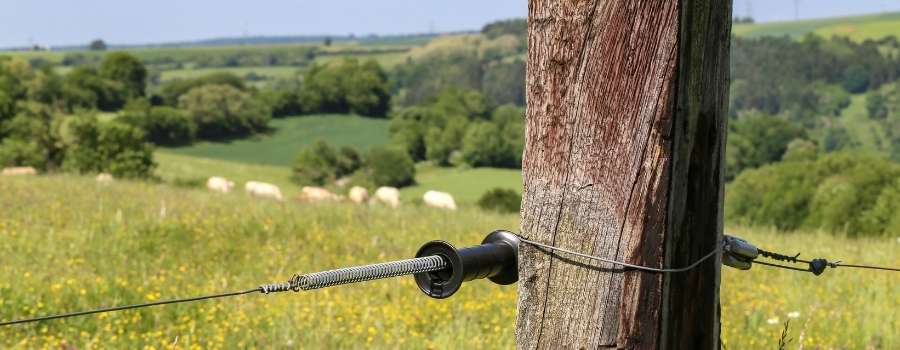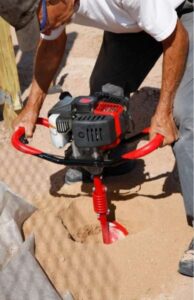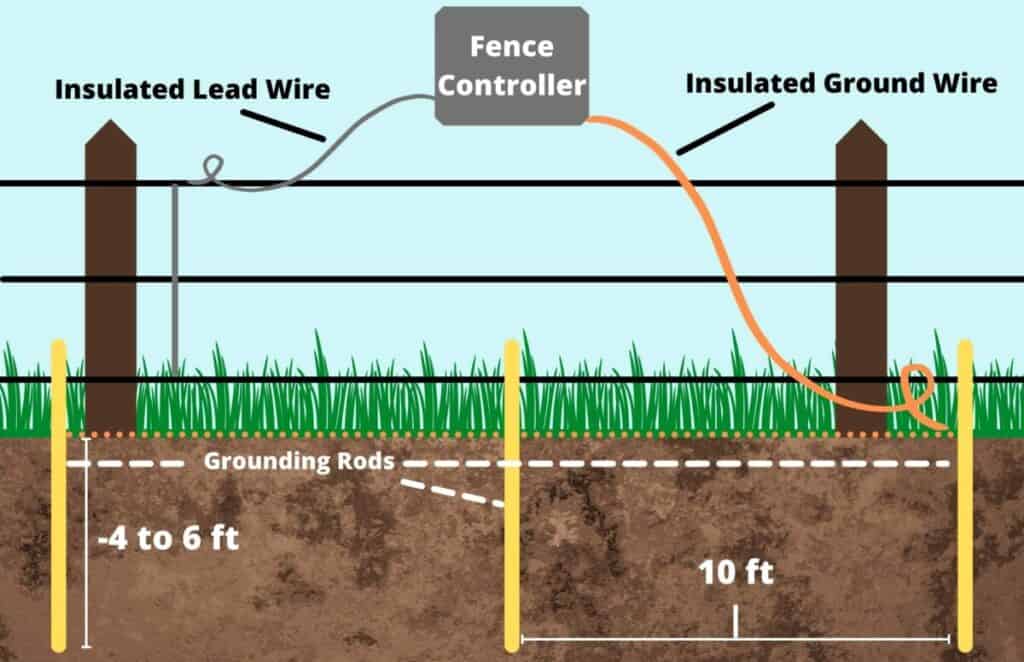
More and more people are starting to become more self-sufficient and “living off the grid” is becoming more and more a part of people’s lives.
With this more self-sufficient living comes the need to grow your own food and raise your own animals like chickens. With raising animals comes the need to protect them from predators…one of the best ways to do this is with an electric fence.
Grounding rods for electric fences are a necessary part of any electric fence system. Without a grounding rod, your fence will not work properly and could cause injury to those who touch it.
I’ve put together this guide covering some common…and not-so-common questions about electric fence grounding rods you should consider before installing an electric fence.
Do You Need A Grounding Rod For An Electric Fence?
On average, an electric fence will need at least 3 grounding rods placed about ten feet apart around the perimeter of your fence. Grounding rods are essential since they are what will carry the electric current throughout the entire electric fence system.
However, if you have a large area to cover with fencing…you may need more than just three grounding rods. It all depends on how much voltage and amperage you plan on running through your fence.
The more voltage you plan on using the bigger distance between grounding rods will need to be…and vice versa with less amperage requiring closer ground rod placement.
However, the experts recommend erring on the side of caution and planning for a larger spacing than what is actually needed since it’s easier to add another rod if you need one…than to take a grounding rod away.
I’ve had people tell me they don’t think their system needs a grounding rod because the wire is grounded to itself…This might work in some cases, but it’s not 100% effective and can lead both for people who try to touch the fence (thinking its de-energized) as well as animals which may be able to get inside of your electric fence line without getting shocked by chewing on the fence.
How Do You Ground An Electric Fence?
The most common type of grounding rod you’ll find is the standard steel ground rod which can be pounded into the ground with a sledgehammer.
I’ve attached this short video that shows these steps in more detail, but here is a list of steps that you’ll need to take to ground an electric fence:
- Hammer your ground rods into the ground to a depth of roughly 4 feet.
- Attach rod clamps to the ground rods and connect your wire to the clamp.
- Run the ground wire to the ground terminal.
- Plug in your your charger (or turn on your solar charger.)
- Go down the length of your fence and spot check the line with a volt tester.
As mentioned before, the more voltage you plan on using for your fence the bigger distance between grounding rods will need to be. For most people, this isn’t that big of an issue since they’re only running a single hot wire through their fence. This means even if the ground rods are a little bit apart…the fence will still work fine.
However, if you’re planning on running more than one or two hot wires for your electric fence (which is becoming more and more common) be sure to get extra grounding rods so they can be spaced about ten feet apart from each other.
Can You Use Rebar As A Grounding Rod For An Electric Fence?
In general, using rebar as an electric fence grounding wire is not recommended because of how difficult it would be to attach the wire from your fence to the ground bar and also due to the fact that rebar can rust.
Galvanized ground rods are typically recommended as they will last a very long time and not corrode like rebar would due to the effects of electricity, weather…etc. If you can’t afford galvanized grounding bar installation it’s better to just use a cheaper metal such as copper which is still relatively inexpensive compared to galvanized rods.
With that said, you could technically use rebar and they should work just fine…providing it’s within distance recommendations mentioned above. If you are going to use rebar as your grounding rod, make sure they’re at least 12″ long and that the ends of them aren’t too sharp…you don’t want an animal or person getting cut on it if they accidentally touch it.
The best option is to buy a commercially made metal ground rod, like these 4-foot copper grounding rods by Cimple Co. A four-pack can usually be found for less than $75, but larger packs are available.
Can I Use A Post As A Grounding Rod?
In general, you will not want to use a post as a grounding rod since they are difficult to get to the proper depth grounding rods need to be buried too. They also have a tendency to rust, unless they are made from galvanized metal or copper.
If your posts are galvanized metal, then I suppose you can use them as long as they can be driven to a depth of at least 4 feet…though some experts recommend 6 to 8 feet.

You’ll want to cut the post off about two feet above the ground so it’s easier to attach your wire but make sure there is at least one foot of “stub” left sticking out of the ground.
You may need to use a post hole digger to cut an eight-inch deep trench around the perimeter of your fence. For this, I like to use a gas-powered digger with variable auger bits like this one by ATOLS…it has 4″, 6″, and 10″ bits making it great for other applications like ice fishing…but that’s another article.
The idea here is that you will run the grounding wire along this line so it creates an underground “moat” for electricity to flow through if something gets shocked by touching the live wire on top.
Once you’ve dug the trench, you’ll attach the grounding wire to your posts and connect them to your ground rod. You can either use a metal strap or just twist the two together using pliers.
Once everything is connected, fill in the trench with dirt and pack it down well by stepping on it (or if it’s really dried out…use a shovel.)
Can You Bury An Electric Fence Ground Wire?
In general, burying your electric fence ground wire is fine as long as it doesn’t exceed the distance recommendations of your fence. You also need to make sure that the wire is either metal or green polywire, otherwise, it won’t conduct electricity properly.
If you’re going to bury your ground wire then I recommend using a metal wire since it will last a long time and not corrode as green polywire could.
If you do decide to use metal wire, then just run it along your underground trench line before filling in the dirt with soil…just make sure that no part of the ground wire is sticking out above ground level, or else something could come into contact with it and get shocked.
If you decide to go with green polywire for your ground wire, then you’ll have a little more work ahead of you as it tends to unravel quickly if cut too short. The best thing I’ve found is just to use a spool that has at least 200 feet on it so the insulation doesn’t wear off or unravel as easily.
Once you’ve cut your wire to the desired length, just attach it at each post and connect it to your ground rod using either a metal strap or twisting them together with pliers.
Will Animals Dig Up A Buried Grounding Wire?
As long as you’ve packed the dirt around your grounding wire properly, then animals shouldn’t be tempted to dig it up.
I’ve heard stories about animals digging up a buried ground wire, but I don’t think it’s something you need to worry too much about.
Some people use green plastic garden weed barriers to further protect a buried grounding wire. You can just cut it into long strips and attach your grounding wire by twisting them together, then press the dirt down on top.
What Advantages Are There To Burying An Electric Fence Ground Wire?
- It will keep animals from digging up the line which could cause them to get shocked by touching one of your live wires, or even just getting too close.
- You won’t have any more issues with trees dropping branches on top of it and breaking off a section causing an electrical short in some cases…though this is pretty rare.
What Disadvantages Are There To Burying An Electric Fence Ground Wire?
- It requires a lot more work and can be difficult depending on the terrain you’re working with…especially if its rocky or has a lot of tree roots.
- You’ll have to keep an eye out for any underground water lines that may run through where you want to bury your wire.
- It can be more expensive to buy special insulators for attaching the ground rod since they are usually sold in bulk, so do some research there first before making a decision on how to attach your grounding wire…but whatever you choose, make sure its safe and non-conductive enough not to cause a problem.
- You’ll also need to invest in a post hole digger or hire a crew to do the work for you…unless you just want to use a shovel.

How Do You Ground A Portable Electric Fence?
In general, connecting your portable electric fence to a grounding rod (or two) that you drive into the ground will work. Next, connect the ground rod to the ground connection with a wire from the ground rod.
If you’re using an energizer then it will come with either a green or white wire for this purpose, but if it’s just bare metal wires then you’ll need to buy some special insulators in order to attach them properly.
There are two main types of grounding rods that you can use for an electric fence:
- Metal Rod
- Ground Strip
Metal Rod – this is usually made out of steel so it will last a long time in the ground.
You’ll need to attach your green or white wire to it using either plier, special clips/insulators, or even just twisting them together.
Ground Strip – this is usually made out of plastic and can be buried just like your electric fence since it’s pretty much in one piece, but you’ll need to attach the green or white wire using clips/insulators.
The best thing I’ve found for attaching ground strips are small metal clamps which work well either way.
Final Thoughts
Grounding rods for electric fences are used to ensure that your fence is properly grounded and safe. They also provide a third point of contact which can help reduce the chance that an animal will be shocked while trying to get through or damage the fencing.
Ground strips, metal rods, and plastic ground strips all have their own unique advantages so you’ll want to choose one based on what works best in your specific situation.
For example, if you’re using a portable electric fence then connecting it directly with a grounding rod may work better than burying wire depending on where you need protection from animals digging up wires and getting electrocuted by touching them accidentally.
Whatever type of grounding system you use for your electric fence though, make sure it’s made out of materials that won’t conduct electricity to reduce the chance of animals getting shocked.
